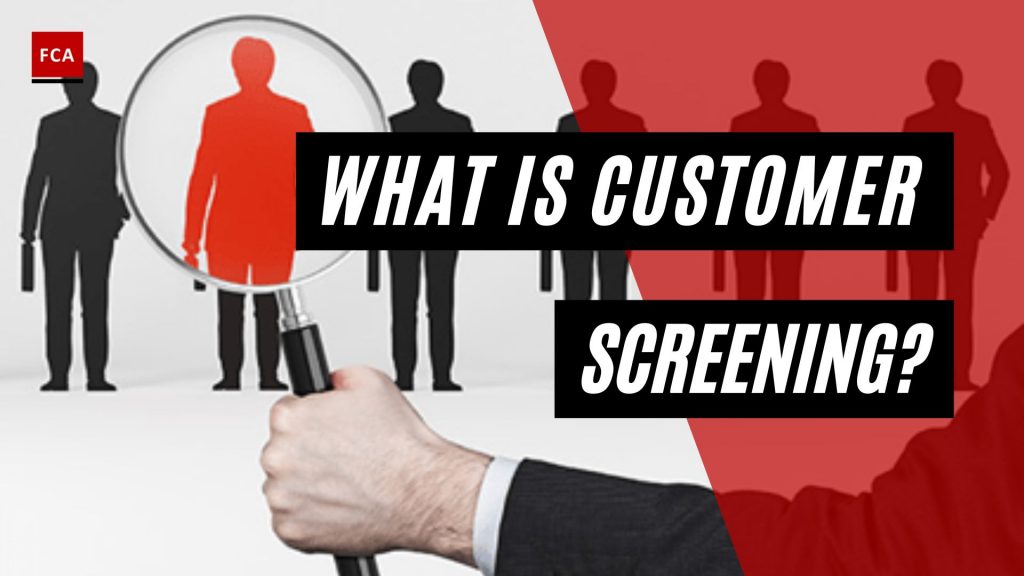What is customer screening? Customers must be screened in accordance with applicable AML/KYC regulatory requirements, such as those outlined in the Financial Crime Enforcement Network (FinCEN), Foreign Corrupt Practices Act (FCPA), Providing Appropriate Tools Required (to) Intercept (and) Obstruct Terrorism (USA PATRIOT) Act, and so on. Companies doing business in the United Kingdom must comply with the Proceeds of Crime Act 2002 (POCA) and the Terrorism Act 2006. As a result, anti-money laundering (AML) and counter-terrorist financing (CFT) law affects more than simply financial institutions.

What Is Customer Screening?
Customer screening is emphasized in all AML/CFT regulatory requirements prior to onboarding a customer and establishing a commercial relationship. The due diligence procedure is incomplete without proper customer screening. The account opening team or officer must guarantee that the identity information, such as name, business data, and so on, is screened against the state or regulatory authority’s negative lists.
Customer screening assesses a customer’s position in terms of receiving bad news, being identified as a PEP, or being a potential criminal. To determine if the clients are genuine persons or businesses, the names and contact information must not show on any negative lists or searches. One of the most crucial elements in a customer’s due diligence is the screening procedure.
Data used in the screening process contains names, addresses, countries, and dates of birth. Data may also include company registration and other related details, and data on key executives, stakeholders, and even beneficial owners. This screening data is likely to contain anomalies that will reduce the accuracy of the screening process, but it is also likely that the data used for screening against the government and commercial lists will also have anomalies that will impact the customer screening process and the results obtained may not be correct.
False positives contribute to an excess of administrative work because they must be investigated. They require a significant amount of effort to sift through possible matches in search of contradictory evidence. The false positives cost the organization money. False negatives, however, may cost the reputation of the organization.
Effective Screening Requirements
Effective screening requires the use of accurate information and lists and the performance of comprehensive investigation. The following are key requirements for effective watchlist screening:
- With high levels of inaccuracies and inconsistencies often persisting in both customer data and watchlist sources, accurate data preparation is fundamental to achieving screening accuracy;
- The sources of screening should include lists of sanctions, prohibitions, and PEPs and special interest persons; internal black lists and white lists; and lists of other internally sanctioned individuals and entities;
- As many sanctions lists are scripted in Latin characters, therefore, the accurate customer screening requires an ability to reliably match data across multiple scripts including non-Latin alphabets such as Arabic, Chinese, and Cyrillic;
- “Exact” and “inexact” name matching should be performed using search appropriate techniques, even when data is misspelled, incomplete, or sometimes missing;
- Screening should be conducted at intervals appropriate to the risks faced by the organization, and in real-time when establishing new relationships with individuals and entities;
- An effective customer screening must be able to connect to multiple sources and automatically integrate different types of data from different systems;
- The screening process should allow for easy creation of multiple names data sets for possible matches;
- A screening process is required to ensure that only genuine risk entities are identified.
Why Screen?
The primary goals of screening are to manage the risk of doing business with bad actors, such as sanctioned or wanted individuals, and to identify customers or prospective customers who pose an elevated risk of criminality, such as PEPs, so that appropriate risk management measures, such as enhanced due diligence, can be implemented. The overarching goal is to manage your organization’s risk of money laundering, terrorist financing, or any other form of predicate criminality such as bribery and corruption, terrorist financing, or tax crimes.
Customer screening is required by most countries’ anti-money laundering (AML) laws and applies to all businesses operating in AML-regulated sectors such as banking, finance, law, accountancy, trust and corporate service providers, real estate agents, high-value goods dealers, insurance, lending, and gaming.
Why Screening Matters?
In almost all jurisdictions, violating sanctions—doing business with a sanctioned individual or entity—is a criminal offense. Regulators and prosecutors are increasingly harshly penalizing businesses that fail to adequately screen customers or risk rate them appropriately. Regulators don’t even need to show that an organization was exposed to criminality as a result of their customers’ activities – simply demonstrating that its AML controls were inadequate is sufficient.
Final Thoughts
Screening is the process of dynamically comparing data on customers, prospective customers, suppliers, and counter parties to data held in external data sources such as sanctions lists, watch lists, PEP lists, and adverse media for risk management purposes.








